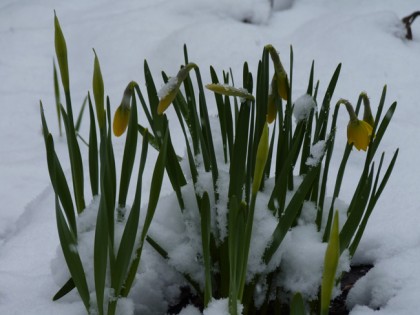Spring Anniversary Moon
“In the latter half of the 20th century, the spring emergence of leaves, frogs, birds and flowers advanced in the Northern Hemisphere by 2.8 days per decade.” NYT, The Seasons Aren’t What They Used To Be*, March 19, 2017. See an NYT graphic representation here.

We’re celebrating the spring equinox with yet another red flag warning. We need precipitation. Spring in the mountains is not yet, though the temperatures felt like it this whole last week.
A while ago I asked an entomologist at the Cedar Creek Nature Center in Anoka County what was the key phenological sign of spring. Bloodroot blossoming was his answer. Up here on Shadow Mountain it seems to be pasque flowers and they are blooming. Yet in many years, most years, there would be no pasque flower blooms now due to snow cover.
On the Great Wheel, the spring equinox is the point when the promise of Imbolc’s freshening of the ewes begins to appear in the plant kingdom. Leaves push out. Spring ephemerals hurry up and bloom, getting out ahead of tree and shrub leaf shade. Buds for later blossoms appear. Green pushes out brown. The sound of tractors are heard in the fields.
This storied season has a vital presence in poetry, song and many of the world’s religions. Mother earth seems to defy the fallow season, the cold season by creating life abundant from little more than sun and soil. No wonder the tales of resurrection in Christianity, in the Egyptian legend of Osiris and Isis, and the Greek’s Orpheus and Euridice, Demeter and Persephone have their analogs in spring.
 Yet it is not a true analog. Mother earth only seems to defy winter and the fallow time. It is not, in fact, death and resurrection, but a continuum of growth, slowed in the cold, yes, but not stopped forever, then magically restarted. Corms, bulbs, tubers and rhizomes all store energy from the previous growing season and wait only for the right temperature changes to release it. Seeds sown by wind and animal, by human hand are not dead either. They only await water and the right amount of light to send out roots and stalks.
Yet it is not a true analog. Mother earth only seems to defy winter and the fallow time. It is not, in fact, death and resurrection, but a continuum of growth, slowed in the cold, yes, but not stopped forever, then magically restarted. Corms, bulbs, tubers and rhizomes all store energy from the previous growing season and wait only for the right temperature changes to release it. Seeds sown by wind and animal, by human hand are not dead either. They only await water and the right amount of light to send out roots and stalks.
 I prefer the actual analog in which human and other animals’ bodies, plant parts and the detritus of other kingdoms, all life, return their borrowed materials to the inanimate cache, allowing them to be reincarnated in plant and animal alike, ad infinitum. Does this deny some metaphysical change, some butterfly-like imaginal cell possibility for the human soul? No. It claims what can be claimed, while reserving judgment on those things that cannot.
I prefer the actual analog in which human and other animals’ bodies, plant parts and the detritus of other kingdoms, all life, return their borrowed materials to the inanimate cache, allowing them to be reincarnated in plant and animal alike, ad infinitum. Does this deny some metaphysical change, some butterfly-like imaginal cell possibility for the human soul? No. It claims what can be claimed, while reserving judgment on those things that cannot.
After Beth Evergreen’s mediation shabbat service last week, a member of the congregation and I got on to the topic of death. “I think it will be like before I was born,” he said. “Yes, I’m a nihilist, too,” I said. “But, I admit the possibility of being surprised.” He agreed.
 It is spring, I think, that gives us this hope, no matter how faint, that death might be only a phase change, a transition from this way of becoming to another. It’s possible.
It is spring, I think, that gives us this hope, no matter how faint, that death might be only a phase change, a transition from this way of becoming to another. It’s possible.
“A necessary complement to the objectivity of science, then, is the subjectivity of experience. An enthusiastic openness to the lives of other species — the timing of tree blooms on city streets, the calls of frogs in wetlands or the arrival of migratory birds — is an act of resistance to deceptions and manipulations that work most powerfully when we’re ignorant. “Post-truth” does not exist in the opening of tree buds.” ibid
